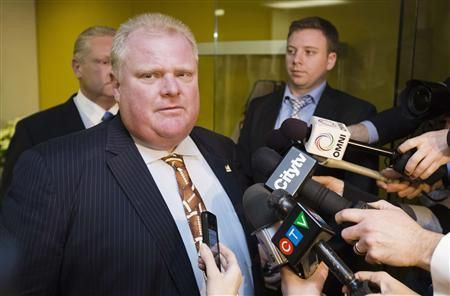Gawker’s Crackstarter Should Fail: Your Life Will Be Better If Indiegogo Campaign To Buy Rob Ford Crack-Smoking Video Fell Short Of Its Goal

Gawker’s “Rob Ford Crackstarter” campaign is a great idea in the way that sporks or reality TV were great ideas. That is, it’s great that someone was creative enough to think of it, but in the long run, we’d all be better off if it failed.
Not only does the campaign attempt to dress up old-fashioned checkbook journalism as some noble equalizer of valuable information, but it also drags the good-will principles of crowd-funding even deeper into the mud than they already are -- and just when websites like Kickstarter and Indiegogo looked as if they might recover from the Great Zach Braff Scandal of four weeks ago.
In case you haven’t been following along, here’s how Gawker describes its efforts:
“Toronto Mayor Rob Ford smokes crack cocaine. Gawker is trying to purchase a video of Ford smoking crack cocaine. If we raise $200,000, the owners have promised to hand it over so we can publish it online … Gawker editor John Cook has watched the video, as have two reporters for the Toronto Star.”
Since the campaign launched, Twitter and other websites have seen an outpouring of support from “go, Gawker, go” cheerleaders, more than 4,400 of whom have already pitched in to help the website reach its goal. After an apparent slowdown, the campaign has picked up steam since Monday. With six days to go, Gawker has raised more than $110,000.
That kind of support speaks to the aforementioned greatness inherent in any genuinely new idea. Everybody wants to be part of something new. But those thousands of Gawker loyalists dropping $5 and $10 for a piece of the crack-video pie have missed the more important point that the campaign serves no objective purpose outside of publicity for Gawker, which Gawker will receive whether its fundraising goal is reached or not.
This is not to say that the video contains no value. If it’s authentic, it most certainly does. Indeed, one of the strongest arguments in favor of Gawker’s “Crackstarter” is that to expose the combative Mayor Ford for his crack-smoking ways is to provide a service for the people of Toronto. But arguing that point assumes we live in an alternate universe where the crack-smoking video would be kept hidden from the public in the absence of Gawker’s “Crackstarter.” We all know that’s not true.
This video of the mayor of a major North American city hitting the pipe, if it indeed exists, will be seen. It’s a mathematical certainty. And that’s true whether Gawker pays $200,000 for it, or whether its creators upload it to YouTube for free. There is something about being in the possession of high-interest material that creates a need to share it. The creators of the video, who are reportedly Somali drug dealers, have been shopping it around to various news outlets. They’re going to share this thing, with or without your money. But at least if Gawker fails, we can expect to see fewer copycat “Crackstarters,” which would mean fewer news outlets asking their readers to bankroll their virality, which would mean fewer people paying to watch incriminating videos, which would mean a better world.
In considering how the “Crackstarter” campaign will play out over the next six days, let’s look at the two possible scenarios. In scenario A, Gawker raises $200,000, pays for the video, and a lot of people see the mayor of Toronto smoking crack. In scenario B, Gawker fails to raise the money, the video ultimately lands in the hands of another outlet or on YouTube, and a lot of people still see the mayor of Toronto smoking crack. The only difference in scenario A is that lot of people paid money to see something they would have seen anyway. There’s a word for that in crowd-funding. It’s called Braffian.
Got a news tip? Send me an email. Follow me on Twitter: @christopherzara
© Copyright IBTimes 2024. All rights reserved.






















